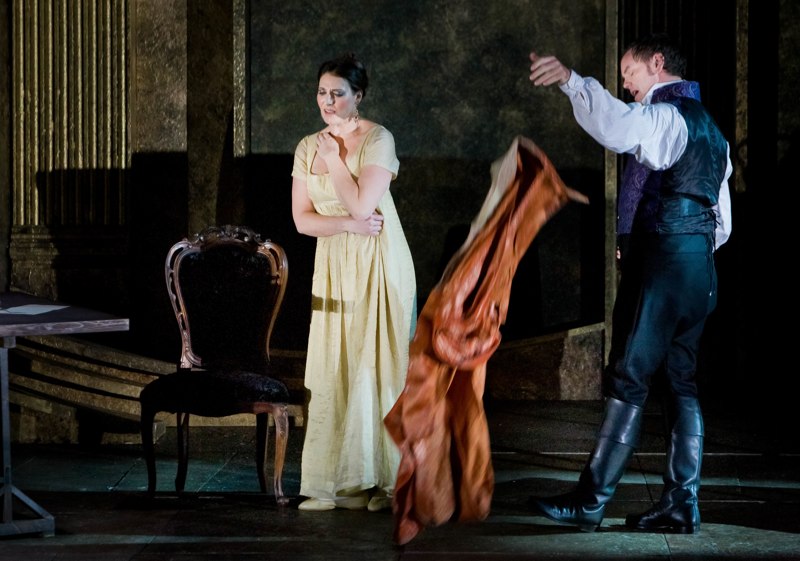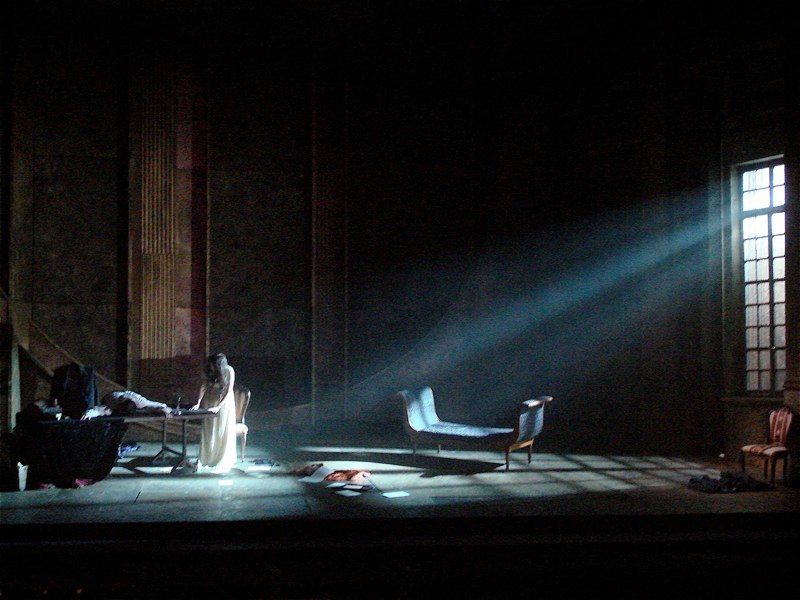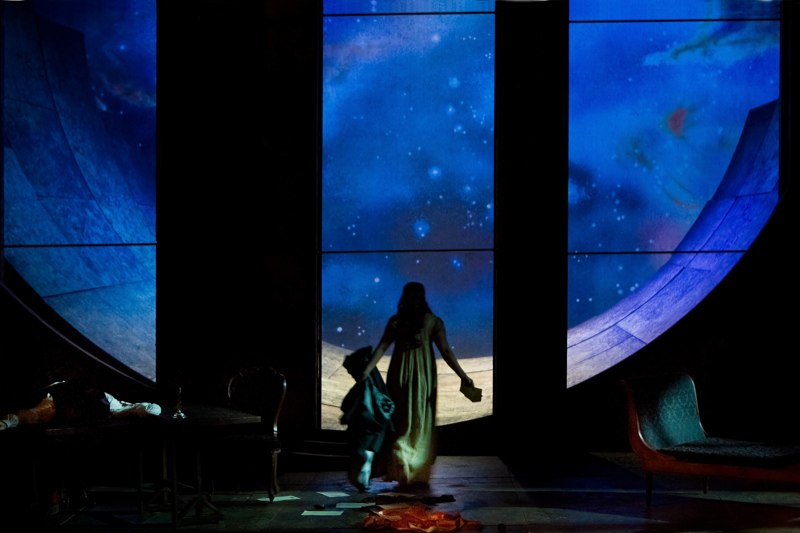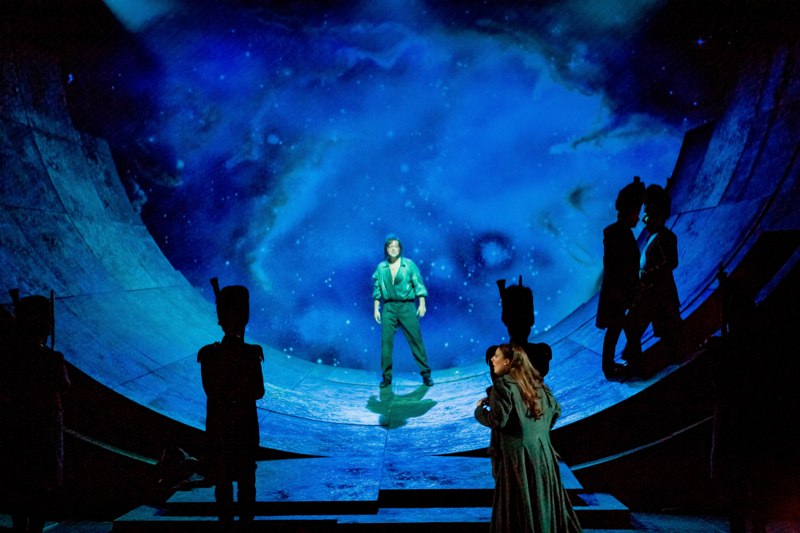TOSCA
ENGLISH NATIONAL OPERA
May 2010
SET DESIGN | Frank Philip Schlössmann
COSTUME DESIGN | Gideon Davey
LIGHTING DESIGN | David Martin Jacques
CONDUCTOR | Edward Gardner
CAST | Amanda Echalaz | Julian Gavin | Anthony Michaels-Moore | Jonathan Veira | Paul Putnins
PHOTOGRAPHY | Robert Workman | Tristram Kenton
What’s On Stage | Jenny Beeston | May 2010
“Little in recent memory has hit the mark so consistently and so truthfully as the simple, traditional storytelling of diva-turned-director Catherine Malfitano.”
The Arts Desk | Igor Toronyi-Lalic | May 2010
“Rarely have I seen an opera where so much of the activity, so much of the detailed business of relating, loving, falling out and hating, has rung so true for so much of the time. And never do I remember this truthfulness coming from such simplicity. For, in terms of set, costume and conception, this is a very ordinary, recognisable, dependable, 19th-century Tosca, But what soprano-cum-director Catherine Malfitano (once a star Tosca herself) does with these familiar ingredients is quite extraordinary. We don’t have to wait long for the first sign that Malfitano’s handling of the drama will be special, the curtains rising on a palpitating cloak bent under the church sanctuary. We are, of course, glimpsing the crazed freedom-fighter Angelotti, whose decision to steal himself away to the sacristy will lead to the massacre of the three leads. It’s one of several chilling and slightly mysterious stills that haunt this production. Malfitano’s next moment of brilliance is what gives the opera its heartbeat: the love scene. Oh boy, what a love scene. Usually there’s something forced about the amount of time it takes for the embrace, the fallout and reconciliation of Tosca and Cavaradossi to work itself out. Here, it seemed like the most natural thing in the world. Malfitano has them both fly across the church after their row, sitting slumped on two opposing pillars, Cavaradossi slowly crawling back towards Tosca with entreaties, Tosca flirtatiously still. It’s a stroke of genius to have them apart and restrained during this moment of high musical passion. Like two charged magnets you could almost see blue sparks flying between them. This was a Tosca at its plainest, simplest and most inspired.”
Evening Standard | Barry Millington | May 2010
“The progression from a traditional singer-directed staging, albeit full of neatly observed detail, to something more conceptual is one of the evening’s big surprises. [Tosca’s] unconventional backwards “leap” from the battlements is the other.”
The Telegraph | Rupert Christiansen | May 2010
“The result is surprisingly impressive: singers don’t have a great track record as directors, and I anticipated something much lamer than Malfitano has provided. ...What matters is the fine stagecraft and the rich psychological detail with which characters and their relationships are defined: Tosca’s jealousy of the Marchesa is not an irrational diva-ish explosion so much as an erotic tease; Scarpia is more sexual deviant than melodramatic sadist; and I’ve never seen his first entry or his murder handled with such assurance and clarity. ...This is an intelligent and forceful interpretation, and I think it will prove durable.”
The Guardian | Andrew Clements | May 2010
“The company’s new Tosca, with which Catherine Malfitano makes her debut as a director in this country, should last for a healthy number of reincarnations. It is unlikely to date quickly, either. ...The depth of [Malfitano’s] experience is revealed in the unfussily registered detail, and the carefully composed stage pictures...every detail in the narrative is thoughtfully realised....”
Music OMH | Keith McDonnell | May 2010
“...Here at last is a production that one can foresee being revived many times.... Malfitano certainly knows what to say about the piece and... thankfully avoided all the cliches that most stagings are lumbered with...hers was an intelligent reading as I have seen.”
The Financial Times | Andrew Clark | May 2010
“Malfitano finds enough unobtrusive variants on tradition to make us realise that this is not an old production, even if it could reasonably pass for one. Most of the Tosca cliches are avoided. Shafts of humour in the early scenes sharpen the contrast with Scarpia’s arrival, strikingly announced by henchmen in top hats and black capes, swooping on the Sacristan’s party like vultures on the prowl. Act Two reaches a climax of gory breathlessness, and Act Three opens with some atmospheric scene-setting for off-duty guardsmen. The heroine doesn’t plunge to her death so much as fall backwards.”
The Times | Neil Fisher | May 2010
“...Malfitano’s biggest achievement on the stage of the Coliseum is to pass her dramatic nous on to another soprano, here the gutsy Amanda Echalaz. Here’s a Tosca who is both imperious and not afraid to mock her own pretensions. Moments after demanding that Cavaradossi repaint his new Madonna with black eyes like hers, she is giggling at her own cheekiness. ...By the end, out of ideas, Echalaz sails backwards into the void...more out of existential ennui than hopeless rage. It’s a fresh spin on what can often be another hammy Tosca moment.”
The Classical Source | Graham Rogers | May 2010
“[Malfitano] brings her experience to bear in a sensitive interpretation that shows instinctive understanding of Puccini’s score, and which contributed immeasurably to the terrific success of the performance. Though essentially traditional, there is no hint of staleness to Malfitano’s production. Every moment of the drama is brought to life enthrallingly, a remarkable achievement with such a familiar opera. The acute passion and emotion genuinely hit home, often painfully so. The skin crawled as Scarpia leaves a distraught Tosca no choice but to give him the sexual gratification he craves, a scene that bristled brilliantly with truly repulsive dirtiness; Cavaradossi’s torture, though off-stage, was palm-sweatingly vivid. Though we know the joyous hope expressed by the lovers at the start of Act Three is false, such is their overwhelming conviction we could almost believe things might turn out differently this time. The tragic denouement carries all the more weight; Tosca’s final desperate act of defiance, hurling herself from the battlements, has never been so shocking or looked so convincing. ...The genius of Puccini shines out afresh in this new ‘Tosca,’ which is an outright triumph. This production should have a long future.”
The Opera Critic | Colin Anderson | May 2010
“Whether one could have worked out without knowing that a distinguished Tosca was directing this new production I am not sure. Certainly throughout there is an appreciative synching of action and music and there is also a thoroughly satisfying sureness of approach from the singers, allowed to focus on their roles and not hindered by production-baggage."




















